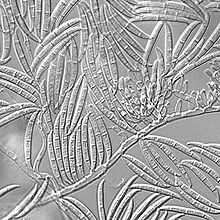Gibberella
This article is missing information about "One fungus one name" situation. G. zeae is going by its anamorph name on Index Fungorum and MycoBank now, what about the others?. (December 2023) |
| Gibberella | |
|---|---|

| |
| Macroconidia of Gibberella zeae | |
| Scientific classification | |
| Domain: | Eukaryota |
| Kingdom: | Fungi |
| Division: | Ascomycota |
| Class: | Sordariomycetes |
| Order: | Hypocreales |
| Family: | Nectriaceae |
| Genus: | Gibberella |
| Species | |
|
See text | |
Gibberella is a genus of fungi in the family Nectriaceae.
In 1926, Japanese scientists observed that rice plants infected with Gibberella had abnormally long stems ("foolish seedling disease").[1]
A substance, gibberellin, was derived from this fungus. Gibberellin is a plant hormone that promotes cell elongation, flower formation, and seedling growth.[2]

Etymology[edit]
Pier Andrea Saccardo named the genus "Gibberella" because of the hump (Latin, gibbera) on the fungal perithecium.[3]
Species[edit]
- Gibberella acerina
- Gibberella acervalis
- Gibberella africana
- Gibberella agglomerata
- Gibberella atrofuliginea
- Gibberella atrorufa
- Gibberella australis
- Gibberella avenacea
- Gibberella baccata
- Gibberella bambusae
- Gibberella bolusiellae
- Gibberella bresadolae
- Gibberella briosiana
- Gibberella butleri
- Gibberella buxi
- Gibberella cantareirensis
- Gibberella cicatrisata
- Gibberella circinata
- Gibberella coffeae
- Gibberella coronicola
- Gibberella creberrima
- Gibberella culmicola
- Gibberella cyanea
- Gibberella cyanogena
- Gibberella cyanospora
- Gibberella cylindrospora
- Gibberella effusa
- Gibberella engleriana
- Gibberella euonymi
- Gibberella ficina
- Gibberella flacca
- Gibberella fujikuroi
- Gibberella fusispora
- Gibberella gaditjirrii
- Gibberella gordonii
- Gibberella gossypina
- Gibberella heterochroma
- Gibberella hostae
- Gibberella imperatae
- Gibberella indica
- Gibberella intricans
- Gibberella juniperi
- Gibberella konza
- Gibberella lagerheimii
- Gibberella lateritia
- Gibberella longispora
- Gibberella macrolopha
- Gibberella malvacearum
- Gibberella mapaniae
- Gibberella maxima
- Gibberella nemorosa
- Gibberella nygamai
- Gibberella parasitica
- Gibberella passiflorae
- Gibberella phyllostachydicola
- Gibberella polycocca
- Gibberella pseudopulicaris
- Gibberella pulicaris
- Gibberella quinqueseptata
- Gibberella rhododendricola
- Gibberella rugosa
- Gibberella sacchari
- Gibberella spiraeae
- Gibberella stilboides
- Gibberella subtropica
- Gibberella thapsina
- Gibberella tilakii
- Gibberella tricincta
- Gibberella tritici
- Gibberella tropicalis
- Gibberella tumida
- Gibberella ulicis
- Gibberella venezuelana
- Gibberella violacea
- Gibberella vitis
- Gibberella xylarioides
- Gibberella zeae
See also[edit]
References[edit]
- ^ Kalra, Geetika; Bhatla, Satish C. "Chapter Gibberellins". Plant Physiology, Development and Metabolism. Singapore: Springer. pp. 617–628.
- ^ Hu, Yilong; Zhou, Limeng; Huang, Mingkun; He, Xuemei; Yang, Yuhua; Liu, Xu; Li, Yuge; Hou, Xingliang (2018). "Gibberellins play an essential role in late embryogenesis of Arabidopsis". Nature Plants. 4 (5): 289–298. doi:10.1038/s41477-018-0143-8. PMID 29725104. S2CID 19164479.
- ^ GIBBERELLA FROM A (VENACEAE) TO Z' (EAE), by Anne E. Desjardins; originally published in Annual Review of Phytopathology, 2003. 41:177–98; doi:10.1146/annurev.phyto.41.011703.115501
External links[edit]
